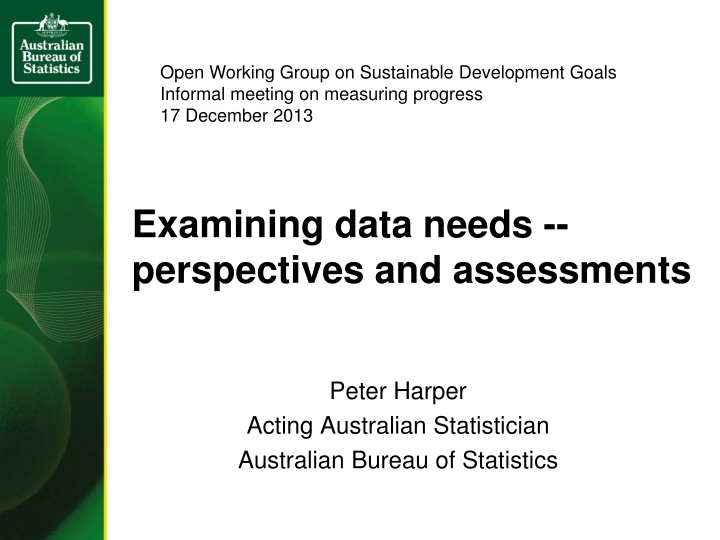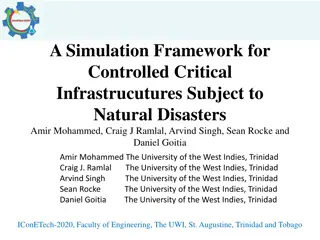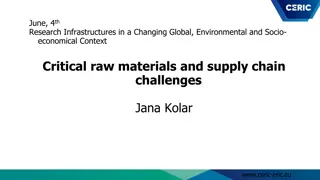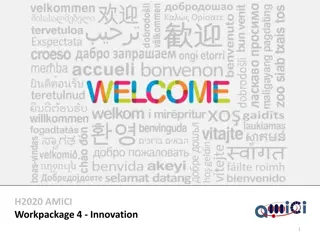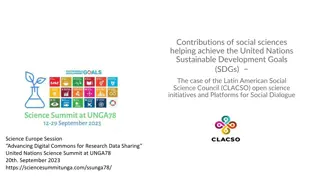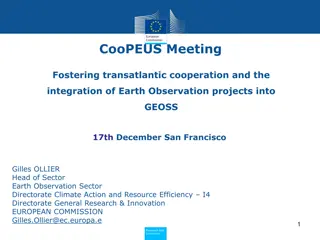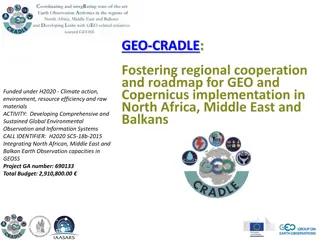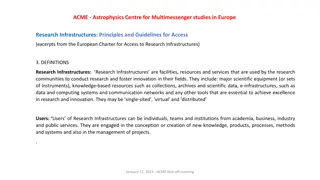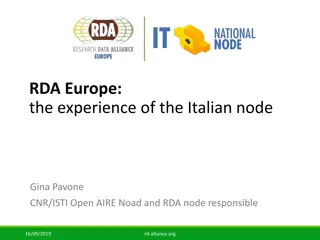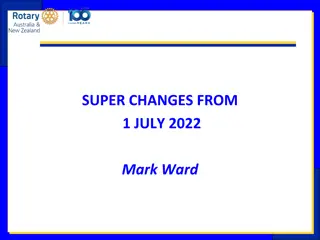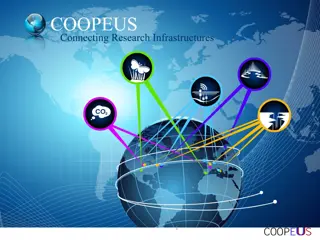Contributions of Environmental Research Infrastructures to GEOSS
Environmental research infrastructures play a crucial role in advancing our understanding of oceanic and atmospheric processes, long-term climate system development, biodiversity, and more. These infrastructures support the Earth as a complex and coupled system, contributing to multidisciplinary research and data access for system-level studies.
Download Presentation

Please find below an Image/Link to download the presentation.
The content on the website is provided AS IS for your information and personal use only. It may not be sold, licensed, or shared on other websites without obtaining consent from the author.If you encounter any issues during the download, it is possible that the publisher has removed the file from their server.
You are allowed to download the files provided on this website for personal or commercial use, subject to the condition that they are used lawfully. All files are the property of their respective owners.
The content on the website is provided AS IS for your information and personal use only. It may not be sold, licensed, or shared on other websites without obtaining consent from the author.
E N D
Presentation Transcript
Open Working Group on Sustainable Development Goals Informal meeting on measuring progress 17 December 2013 Examining data needs -- perspectives and assessments Peter Harper Acting Australian Statistician Australian Bureau of Statistics
Introduction The High-Level Panel (HLP) of Eminent Persons on the Post-2015 Development Agenda A New Global Partnership (May 2013) and the Sustainable Development Solutions Network (SDSN) An Action Agenda for Sustainable Development (October 2013) offer thoughts on the post-2015 agenda This presentation offers some perspectives and assessments on the data aspects of these reports
Statisticians and policy- makers need to work in partnership You can t manage what you can t measure Constructive, early engagement between official statisticians and policy- makers is critical Official statistics provide the quality and integrity necessary to underpin measurement in the post-2015 world A universal post-2015 agenda is crucial
Roles policy makers and statisticians Policy-makers Statisticians Data sets Goals Targets Indicators
Choosing SMART indicators Specific Measurable Attributable Relevant Timely Official statisticians can offer assistance on all these dimensions
Importance of datasets and standards Indicators derived from well-constructed datasets will be of far greater value Coherent Consistent Comparable Able to be disaggregated Use of international frameworks and classifications is fundamental Welcome support for SEEA in HLP However, new developments will be needed, particularly in social and governance areas
The state of statistics Four dimensions of sustainable development The targets in the HLP and SDSN reports can be mapped to each dimension statistically: Economic statistics GOLD Social statistics SILVER Environment statistics BRONZE Governance statistics TIN Significant work would be required to provide the full-range of statistics in the HLP and SDSN reports, even for countries with well-developed statistical systems
A quick assessment of the HLP report for Australia 54 illustrative targets Category A Doable 11 targets (eg decrease the maternal mortality ratio) Category B Doable with a bit of effort 18 targets (eg improve soil quality, reduce soil erosion and combat desertification) Category C A fair way off 25 targets (eg increase sustainability in government procurements) The illustrative targets proposed by the HLP report are extremely ambitious from a statistical perspective The SDSN report is similarly ambitious
A data revolution Strongly supported BUT Must involve official statisticians and be led by the United Nations Statistical Commission (Rio +20 para 38 provides a mandate) Will need resources Will require significantly enhanced capability Will not occur instantly implications for baselines Needs to be supported by investment in the development of concepts, measurement frameworks and standards Will require focussed efforts Needs to be aligned with national circumstances and requirements Must be coordinated across development partners
Big data a silver bullet? Big data offers enormous potential for increasing statistical information for relatively small costs However big data is often uncertain, of varying accuracy, biased, dirty and unstructured Big data needs to be tamed to make it fit for purpose from a statistical perspective This requires investments in technology and methodology National statistical offices are well-placed to unlock the statistical value of big data and make it accessible for policy makers
Frameworks for measuring progress and sustainability Official statisticians have extensive experience in developing frameworks for measuring progress and sustainability, both at the national and international level Eg EU2020 target/indicator setting, OECD green growth and better life initiatives, UNECE/OECD/Eurostat framework to measure sustainable development, ABS Measures of Australia s Progress These frameworks also have relevance from a policy as well as statistical perspective and policy makers should tap into this expertise as they consider the conceptual frameworks to underpin the post 2015 development agenda It is disappointing to see that this expertise was not recognised in either the HLP or SDSN reports
Statistics as a development target? Without high quality statistics, development cannot be measured, monitored and managed More generally, high quality official statistics are a critical component of effective governance, which itself is recognised as an aspect of development Should there be a development target relating to an effective official statistical systems? The measurement of a country s population is vital to the measurement of sustainability, so there should be a special focus on universal and effective civil registration and vital statistics systems which are the essential underpinnings of population measurement
The last word Effective measurement will be a critical underpinning of the assessment of progress in the post-2015 world This will only occur if there is a strong partnership between policy-makers and official statisticians The focus will be on indicators, but targets and datasets also require attention The recognition of the importance of data in both the HLP and SDSN reports is welcome, but we are early stages Significant attention is needed to ensure that statistics, particularly in developing countries, can meet the requirements of the post 2015 world Official statisticians at both the national and international level are ready and keen to work with policy-makers to achieve an effective partnership
